If you’re at all familiar with Norse mythology, then you likely recall Freya (also spelled Freyja), arguably the most honored goddess in the pantheon. A steadfast goddess of war, beauty, fertility, and sex, Freya is likely to make a hardcore entrance driving a chariot pulled by two…cats?
You read that right – cats. Freya’s arrival, heralded by these two unwavering symbols of femininity, isn’t one that you’d soon forget.
The same can be said of her introduction to the Norse pantheon. Initially seen by the Æsir as a mysterious entity wielding powerful feminine magic, she wasn’t quickly accepted as a symbol of Norse culture, to say the least.
Kidnapped into her role, Freya stood up to the abuse of her captors, commanding respect for her people and changing the face of Norse mythology as we know it.
The Goddess Freyja In History & Myth:
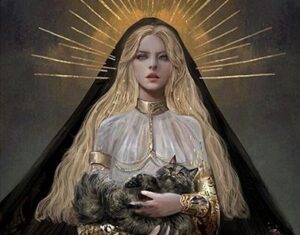
We know from graves discovered in Birka, Sweden that Viking women were often held to the same regard as men, and held notable positions in both politics and battle. We see these themes paralleled in Norse mythology with the divine presence of Freya, who rules alongside Odin in Asgard and is now equally revered.
But scholars know that this was not always the case – let’s take a closer look at the story of Freyja and how she came to be such an important deity in the Norse pantheon.
Freya & The Vanir
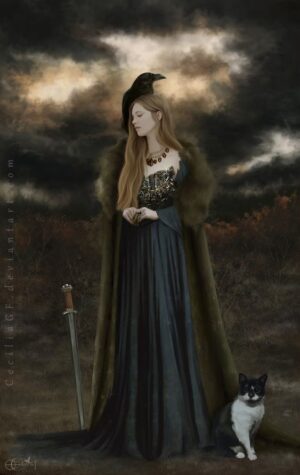
In the beginning, there were two tribes of divine beings: The Æsir and The Vanir.
The Æsir, ruled by Odin, were celestial beings who held domain over war and power. The Æsir resided in the hall of Valhalla, but were entangled in an unending war with their contemporaries, the Vanir.
The Vanir, hailing from Vanaheimr, oversaw matters of fertility, cultivation, wisdom, and divination.
Freya and her brother Freyr were both of the Vanir, taken hostage by the Æsir in one of the numerous violent skirmishes. In many cases, hostages would be exchanged as tokens of goodwill and given positions of honor and power among their new homes, as a form of alliance.
During the war, Freya was attacked in the hall of Odin. There, she was speared and burnt upon a pyre. According to the Old Norse poem, the Völuspá, three times the goddess died, and three times she was reborn.
(Although referred to by the name of Gullveig in the Völuspá, scholars propose that this was either an epithet of Freyja, Freyja in disguise, or that the goddess was renamed after her rebirth and induction into the Æsir.)
Despite murder, bloody battles, and relentless effort from both sides, the Æsir-Vanir War ultimately concluded in a stalemate. Freya, Freyr, and their kin became honorary members of the Æsir.
Freya, a goddess of witchcraft at her core, introduced magic and divination to the Æsir. She taught Odin in the ways of seiðr. In return, Odin gave Freya the high honor of ruling the realm of Fólkvangr and the right to choose first from the worthy souls slain in battle.
It’s interesting to note that Freya is technically an elf, so according to the Norse tradition, our knowledge of magic comes from the Fae.
Fólkvangr
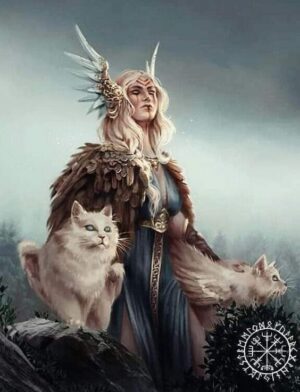
Many have heard of Valhalla, the afterlife of the Vikings, which they were allowed passage to only if they died noble deaths in battle. But did you know that Valhalla is only where half of these fallen warriors were sent?
Few are as familiar with Fólkvangr, Freya’s realm of Asgard, where the other half of those who die in battle are sent to reside. It’s said that of the warriors who have fallen honorably in battle, it is Freyja who gets the first choice among the worthy of the slain.
Those of Freya’s choosing will accompany her in Fólkvangr, while those selected by Odin will enter Valhalla. Both are considered noble and coveted fates among Viking warriors.
These are only two of the twelve realms of Asgard. Common folk among the Nordic communities would toil out the rest of their days in Hel.
Hildisvíni
Freya is often accompanied by her trusty boar Hildisvíni, often depicted in paintings by artist Lorenz Frølich compassionately petting or snuggling him.
In some legends, Hildisvíni is suspected to be Freyja’s husband Óðr in disguise.
In the Poetic Edda, Freyja disguises her protégé, Óttar, as the boar Hildisvíni. In the poem, Freyja rides the boar to meet the seeress Hyndla, whom she then convinces to tell Óttar the information that he seeks.
It is unclear whether Hildisvíni is his own entity or just various men parading around as the same boar to try to get close to Freyja. Nevertheless, it seems to have worked.
More Mystery Behind Freyja’s Origins
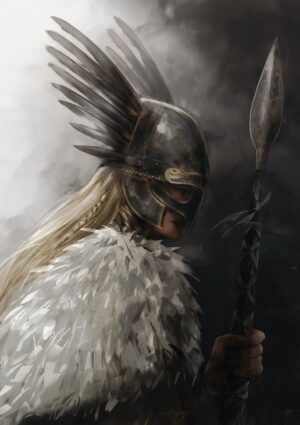
While some recognize and worship Freya and Frigg as two separate goddesses, there’s been some disambiguation in ancient texts. Freya can be roughly translated to the title “Lady”, so one may go so far as to assume that her name, when used in certain contexts, was actually an honorary title and not referring to a separate goddess at all.
Friday, also known as Frigg’s Day, seems to have been adopted by modern practitioners as Freya’s Day as well, lending credence to the notion that the two are one and the same.
Not much is known of Freya’s husband, Óðr, who is often absent. There are even renditions of the goddess shedding golden tears as she awaits his return. As mentioned, some also believe Óðr is accompanying his lady wherever she goes, albeit transmogrified into a boar.
Some historians suspect that Óðr is, in fact, Odin in disguise, which would explain why he’s always got his ‘Away Message’ up. (That’s strictly a millennial reference – if you don’t get it, go ask your mom.)
The Goddess Of Sex
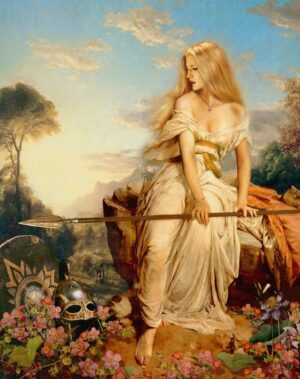
But as they say – when the dog’s away, the uh… cat-drawn-chariot-rider will play? (Nevermind. Just forget I said that.) Anyway, Freyja was a very sex-positive deity and may have even been polyamorous, based on some of her other fringe legends.
She has also lain with the likes of her brother, and famously four dwarves in four nights in exchange for her powerful amulet, the Brisingamen. Her sexual frolicking has been called out by some of the Æsir (we’re looking at you, Loki), which has ruffled a few feathers here and there.
Freya’s Appearance:
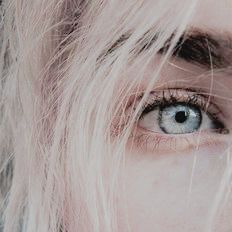
Freya is described as having flowing strawberry blonde locks, and eyes that reflect the sea in both depth and color.
Immensely beautiful and voluptuous, one can easily imagine why Freyja was often hypersexualized in both art and ancient text. Like Aphrodite, Freya is frequently depicted totally nude in paintings and statuary.
In legend, Freya wears a feathered cloak that is crafted from falcon feathers. As an added bonus, anyone who wears Freyja’s feathered cloak is blessed with the power of flight.
Freya was even known to lend out her feathered cloak to those who needed a little help in the fertility department – if you know what I mean. I can’t say I’d be likely to loan out my favorite jacket knowing that it was going to be used under those circumstances but to each their own.
Freya’s Powers:
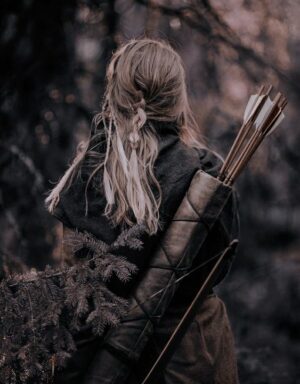
The goddess Freya was known to be a powerful witch, practicing in the divine art of seiðr. Seiðr was a special form of divination that was typically practiced by women, but not without its fair share of taboos. Women who practiced seiðr were considered lascivious at best, and the few men who dared to dabble were looked down upon for their femininity.
Seiðr was a distinct magical practice that couldn’t be performed by just any seer. Pagan reconstructionists believe Seiðr was an elaborate ceremony made up of a series of other detailed magical rituals, performed by a skilled practitioner called a völva.
One of these particular rituals involves the spinning of yarn and textiles. In the act of weaving a physical product, the völva would also manifest her intent. This may be conjuring spirits, seeing events that are occurring elsewhere, foreseeing events that have not yet come to pass, or attracting something of importance to the practitioner.
Seiðr would be practiced with a distaff and spindle, and performed atop a high platform or mountain to allow for a longer spinning ritual. Historians believe the practicing völva would enter a trancelike state during spinning that would allow for a deeper connection to the divine.
How Do You Know If The Goddess Freya Is Calling To You?

Although you can theoretically call upon a deity with extensive amounts of worship, deities often reach out to us when they want to work with us.
The Goddess Freya tends to reach out in very subtle ways. It can be difficult to determine if she is the goddess reaching out to you, but there are a few specific tells.
Some of the indicators that the Goddess Freya is reaching out to you include:
1. Freya appears to you in visions, dreams, or meditation. Freya may approach you when meditating in the woods or in potent dreams during pregnancy.
2. You love learning about the goddess Freya. If the legends and associations of Freyja resonate with you or seem to pop up in your life often, then she may be drawing you in.
3. Freya sends you frequent symbols, like cats, rabbits, and ladybugs. It’s safe to assume that if these critters are in season or live nearby, their presence is just a normal occurrence, but if they seem to be acting out of character or finding you in strange places, then it may be a sign.
Here are some common symbols and associations of Freya that you may want to look for.
Symbols Of Freya
- Cats
- Boars & swine
- Falcons
- Ladybugs
- Rabbits
- Horses
Remember that you don’t have to wait for a deity to reach out to you to work with them! Freya is a friendly and welcoming goddess, so feel free to make the first move by making an offering or altar to her and then asking her directly through divination.
How To Work With The Goddess Freya:

Freya is a goddess of beauty and lends her aid to glamour magic workings. As a sex-positive deity, you can also call upon Freya for assistance in sex magic or self-love rituals. Fertility workings fall within her domain.
Some choose to honor Freya on Friday (also known as Frigg’s Day or Freyja’s Day in Germanic mythology), but you can perform acts of devotion for Freya on any day!
Devotional Acts To Freya

Spend time connecting with nature. Take a walk in the woods, meditate, and ask for Freya’s guidance and advice. Look for creatures and listen to the sounds of nature to hear and see signs from Lady Freya.
Write poems, prose, and songs for Freya. A goddess of the arts, Freya can be honored with songs and poems about her grace and inspiring nature, or even called upon for help when you’re trying to woo someone special in song.
Communicate with Freya via Runes. If you have any knowledge of Runes then I suggest communicating with Freya in this method as this is most natural for her.
Volunteer or donate at your local animal shelter. As a lover of cats (not to mention boars, rabbits, etc.), you can show your devotion to Freyja by donating to local shelters. If that’s not an option for you, consider volunteering your time to help cats and critters in other ways.
Practice green witchcraft or care for your local flora. Plant herbs for Freya or buy houseplants to dedicate to her. This is a great way to bring the greenery of the earth into the home and feel closer to her, even if you live in the city or suburbs.
Perform acts of self-care. In my experience, Freya loves to see us taking mindful care of ourselves through meditation, self-reflection, and working with the specific intent of self-improvement.
Offerings For Freya
Obviously, you should make any offerings that feel right to you. However, I’ve compiled a list of popular offerings to Freya based on her likes and her associations.
- Naturally-shed cat hair or claws
- Rose quartz, amber, tiger’s eye, carnelian, citrine, emerald, or jade
- Silver, gold, and copper
- Necklaces (or any jewelry, really)
- Honey, mead, or wine
- Perfume
- Pink, white, or green candles
- Primrose, holly, hemp, mugwort, or any flowers
- Strawberries, apples, and raspberries
- Celtic knotwork
- Chocolate & strawberries, or any aphrodisiac
What Can You Learn From Freya?

Freyja can teach you to be yourself unapologetically. She is a (literal) warrior. While Freyja might not help you slowly release your trauma, she will teach you to grow a tough skin and make your life what you want it.
She can also teach divination in a variety of ways. If you want to learn divination from Freyja, I suggest leaving and offering and asking her if she’d be willing to give you lessons.
Freya is also quite skilled at witchcraft and Runes. She can bestow blessings on your spells or teach you how to enhance your magic.
Many pagans also work with Freyja on fertility issues. As the Norse goddess of fertility, she’s a wonderful energy to guide pagans through fertility struggles.
My Experience Working With Freyja
I’d like to begin by stating that my experience with Freyja is my own, and that yours may differ depending on your cultural background, your perception of her, and many other factors. However the goddess appears to you, your experience with her, your personal gnosis, and your practice are all valid and accepted in the neopagan community. This is only my personal experience, which I hope paints an effective picture of what it’s like to work with her.
I tend to associate Freyja with the tarot card The Chariot. Maybe for obvious reasons (her feline-drawn chariot is a memorable one, to say the least), but also because of The Chariot’s association with doing whatever the hell you want. The Chariot is about taking life by the reigns, and Freyja’s ambition, drive, sex-positivity, and ability to overcome being burned alive exude just that.
Freyja encourages us to practice self-care – but not so much in the commonly-accepted take-a-bath-and-relax-with-some-candles kind of way. When Freyja reaches out, she is asking you to get up out of bed and grab life by the horns.
Though Freyja is a soft and beautiful woman, she is also strong and fierce. She has taught me that I’m beautiful in my own way. I feel that the Norse deities have a different kind of strength – Freyja really feels like a warrior in and out. Freyja teaches me that I don’t need to rely on anyone else because everything I need is inside of me. She is warm, welcoming, and approachable, but she also gives me a kick in the butt to get going. She embodies the ancient polarity (love and beauty vs. war and death) and teaches me to be both soft and strong.
Overall, Freya is a wonderful guiding presence because she can teach about so many facets of life.


